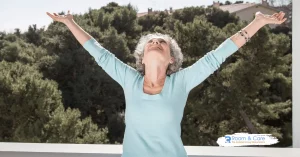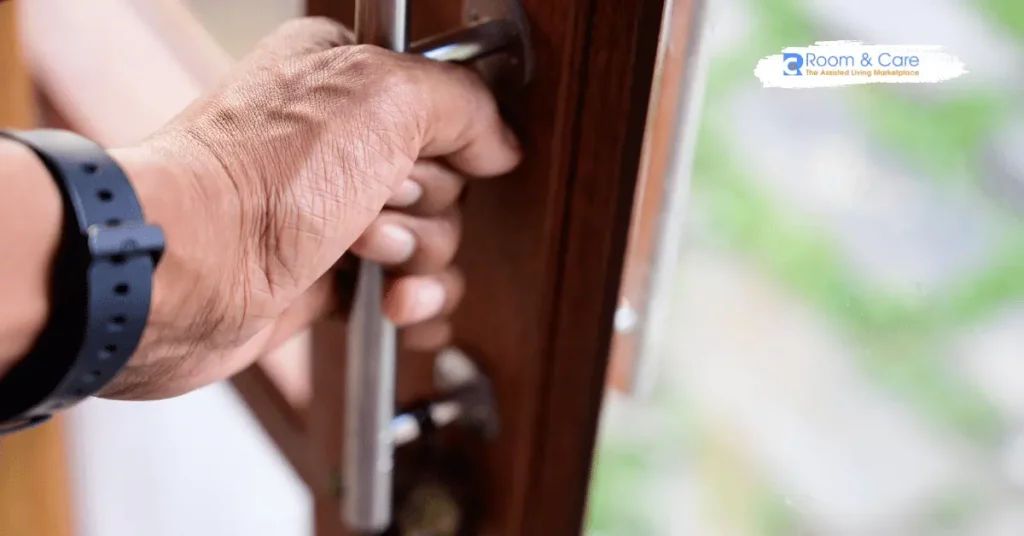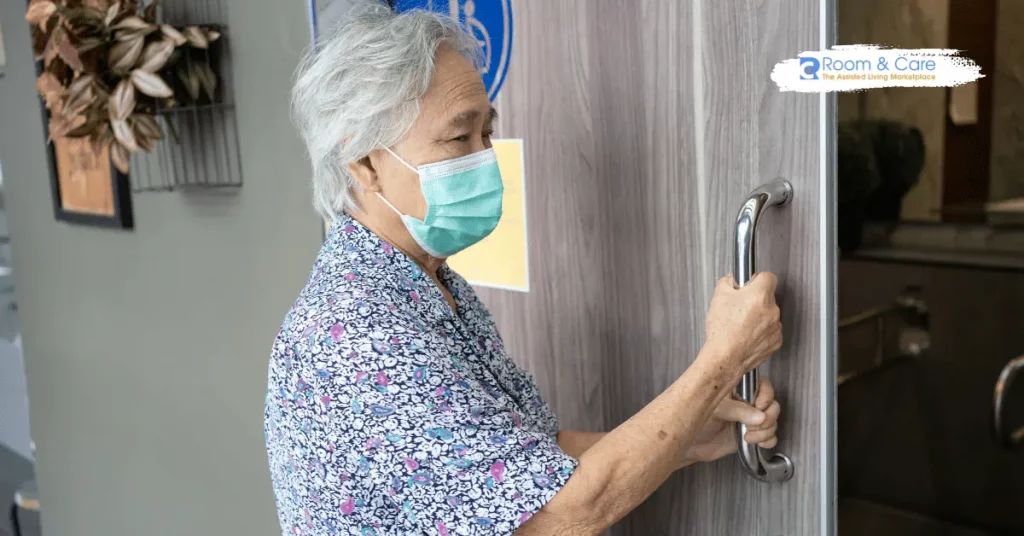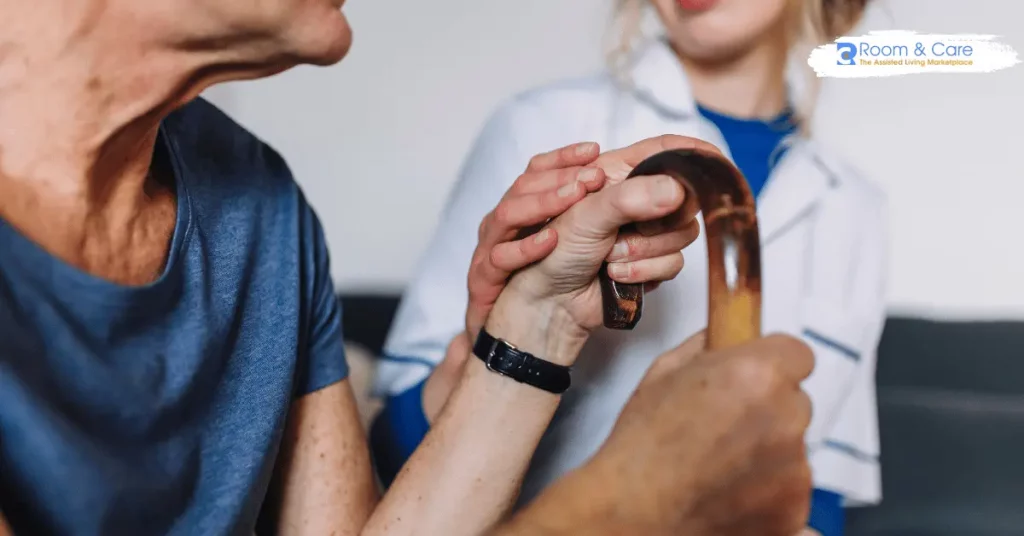

Dementia care involves unique challenges, with safety and independence often at the forefront. For families and caregivers, one primary concern is preventing the risk of wandering while preserving the dignity and freedom of those living with dementia. Specialized door locks can play a crucial role in achieving this balance. This comprehensive guide covers the key considerations when selecting door locks for dementia patients, shares practical advice, and highlights how senior living communities integrate these solutions to create secure environments.
Whether you’re caring for a loved one at home or exploring options in a senior living community, understanding how door locks contribute to safety in dementia care is essential.
A significant aspect of dementia is the tendency to wander, which can lead to safety risks if the person accidentally leaves the home or enters areas that pose hazards. The Alzheimer’s Association estimates that six in ten dementia patients will wander at some point, which can lead to dangerous situations. Specialized door locks help prevent this by limiting unsupervised exits without creating a sense of restriction or isolation.
In settings like memory care facilities and nursing homes, door locks for dementia patients are integral to safeguarding individuals while providing freedom of movement within secure spaces. Here, we’ll explore the key elements to look for when choosing door locks, the benefits they bring in senior living communities, and practical tips for integrating them into daily care routines.
Selecting a door lock for someone with dementia involves more than finding a reliable security measure. The ideal lock provides caregivers with control while respecting the patient’s sense of independence. Here are essential considerations:
Caregivers need locks that are quick and easy to operate, as they manage multiple aspects of a dementia patient’s care. Locks with remote controls, keypads, or emergency overrides ensure caregivers can gain access quickly. For example, some locks can be paired with smartphone apps or fobs, allowing caregivers to lock and unlock doors from anywhere within the home or facility. In a senior living facility, having accessible locks helps staff manage security without limiting mobility, allowing safe access to shared spaces.
A common feature in dementia-specific locks is their design to prevent unintended unlocking by patients. Locks positioned in non-standard locations, such as higher up on doors or with hidden levers, discourage patients from accessing them. Options like double-cylinder deadbolts or keypad locks with unique codes add a layer of complexity, reducing the likelihood of accidental unlocking.
Different doors require different locking mechanisms. For instance, exterior doors may benefit from a double-cylinder deadbolt, while bedroom or bathroom doors could be secured with a less intrusive option, such as a high-mounted latch. For families and caregivers, understanding the types of locks suited to different doors ensures consistent safety throughout the home. In senior care facilities, regulations may also dictate specific lock types based on fire and emergency protocols.
Locks that come with alarms or notification systems provide an added layer of security, particularly in memory care facilities where staff oversee multiple residents. Some locks send alerts to caregivers when a door is opened, giving immediate notice and allowing a swift response. These locks are especially useful in homes with multiple rooms or entrances, where monitoring each door individually could be challenging.
The frequent use of locks in dementia care environments demands high durability. Investing in high-quality, commercial-grade locks helps avoid frequent replacements, reducing maintenance needs. This reliability becomes even more critical in senior living facilities, where secure entry and exit points are used by multiple staff members throughout the day.
While safety is a priority, it’s equally important to avoid making dementia patients feel restricted. Locks that prevent unintentional exits without hindering mobility or autonomy are ideal. Memory care facilities often use door locks with delayed-open mechanisms or double-door systems, which allow residents to navigate within secured areas without direct restraint.

Simply choosing a door lock isn’t enough; how it’s installed and managed can make a significant difference in effectiveness and ease of use. Below are practical tips for setting up locks to maximize safety without sacrificing comfort:
Standard locks are often located in the center or lower section of doors, which may be within reach of dementia patients. By placing locks in unconventional spots, such as the top or bottom of a door, caregivers can reduce the likelihood of the patient discovering the lock. This positioning works well for both exterior and interior doors and is particularly useful when adjusting home environments for safety.
For added security, installing door chimes or alarms can notify caregivers if a door is opened. These are especially effective in homes with multiple rooms or entry points. Many memory care facilities utilize these alarms as part of a broader safety system, allowing staff to monitor residents’ movements without constant supervision.
Delayed-open locks require a button to be pressed continuously for a few seconds before unlocking. This feature prevents quick, accidental exits and is easy for caregivers to manage. These types of locks are effective for exterior doors, where additional security is needed to prevent wandering outside the home or facility.
Introducing new locks can be challenging, so it’s essential to make patients and caregivers comfortable with the system. In cases where the patient may need reminders, use simple and gentle explanations to reduce confusion. Familiarity with the locking system helps avoid distress and can prevent accidents.
Using locks that blend with home decor can make them less noticeable to patients while preserving the comfort and feel of the living space. Caregivers can choose between different styles and finishes that integrate with home or facility interiors, reducing the clinical feel often associated with security equipment.

When considering door locks, families often have several questions. Here, we answer some of the most frequently asked questions to clarify concerns and help guide decision-making.
1. Are electronic locks safe for dementia patients?
Yes, electronic locks can be beneficial, especially those with remote access or notification capabilities. They allow caregivers to monitor doors without physically being present, adding flexibility and convenience. Electronic locks with reliable battery backups ensure consistent operation, even during power outages.
2. What’s the best lock for an exterior door in a dementia care setting?
For exterior doors, deadbolts or double-cylinder locks with a delayed-open feature work well. These locks are sturdy and can withstand frequent use, providing robust security while preventing accidental unlocking. Memory care facilities often choose commercial-grade options for exterior doors to ensure durability and safety.
3. Are there additional safety measures besides locks?
Yes, additional measures include security cameras, personal GPS tracking devices, door sensors, and alert systems. These tools create a layered approach to safety, allowing caregivers to monitor a patient’s movement and reduce wandering risk.
4. Can locks contribute to agitation in dementia patients?
Locks that are too restrictive can cause frustration if patients feel confined. When installing locks, consider the patient’s needs and abilities, choosing a system that secures high-risk areas but doesn’t limit access to safe zones.
5. Should different types of locks be used for different rooms?
Yes, the lock type may vary depending on the room’s purpose. For instance, stronger locks may be necessary for exterior doors, while interior locks can be less intrusive. This strategy works well in memory care facilities and nursing homes, where different areas have different levels of access.
In memory care facilities and nursing homes, door locks are often one part of a larger safety strategy. These communities prioritize resident security while fostering an environment where individuals feel comfortable and independent. Here’s how senior living communities incorporate door locks for dementia patients as part of their safety protocol:
Monitoring Systems and Security Doors: Many memory care facilities use secure entry systems with badge or keycode access. This setup ensures that only authorized staff and visitors can access certain areas. Alarms and notifications enable staff to monitor doors even from a distance.
Creating Safe Outdoor Spaces: Secure outdoor areas allow residents to explore safely, maintaining freedom of movement without the risks associated with wandering. Doors leading to these areas may have locks that alert caregivers when opened, providing an additional safety layer.
Routine Checks and Supervision: Facilities implement regular staff checks on residents throughout the day. For residents who may be prone to wandering, staff use locked doors, video monitoring, and frequent supervision to manage movement while respecting their independence.
At Room and Care, we recognize the importance of balancing safety and independence in senior living communities. Families seeking trusted memory care facilities, nursing homes, and adult family homes can find options on our platform. Room and Care connects families directly with top-rated senior living communities, allowing access without referral fees, thus reducing costs and ensuring direct connections to quality care.
Family caregivers can enhance security at home by following these practical tips:
Not every dementia patient requires the same level of security. Consider the individual’s cognitive abilities and physical mobility when choosing locks, as this will help avoid unnecessary restrictions. For instance, some patients may only require locks on exterior doors, while others may benefit from secured bedroom or bathroom doors.
Explain the purpose of the door locks to other family members and visitors. Understanding the system prevents accidental unlocking and ensures everyone is aware of the safety measures in place. Clear communication and cooperation are key to ensuring consistent security.
Maintaining a consistent daily routine can minimize wandering behaviors and reduce the need for restrictive locks. For patients who need regular outdoor time, incorporate supervised walks or time in a secured outdoor area to balance security with freedom.
Beyond locks, devices like wearable GPS trackers or motion sensors can enhance security. Some systems also integrate with smartphones, allowing caregivers to monitor patients remotely. These tools are especially useful for family caregivers balancing multiple responsibilities, as they provide peace of mind and allow for swift responses when needed.
Healthcare professionals like occupational therapists can provide insights into the most appropriate lock types for dementia patients, considering their mobility and cognitive state. Collaborating with professionals ensures that security measures align with individual care needs.
The right door lock is an invaluable tool in dementia care, offering security and peace of mind for both caregivers and patients. In-home settings, memory care facilities, and nursing homes all benefit from implementing effective lock systems that keep patients safe while preserving their dignity. By understanding the features and types of locks that best suit dementia patients’ needs, caregivers can create a safe, comfortable environment.
For families considering memory care facilities or other senior living options, Room and Care provides a direct connection to quality communities without referral fees. Explore your options today to find the best solution for your loved one’s safety and well-being.